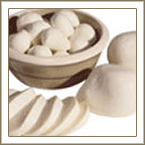
![]()
Heritage:
Called Mozzarella Fresca in Italy where it originated, Fresh Mozzarella was
first made with milk from the water buffalo. Today, Wisconsin cheesemakers
use the same traditional methods of producing this versatile cheese. As a
Pasta Filata cheese, the curds are kneaded, then stretched and formed into
balls or logs. However, this cheese is not cured in brine or aged like the
low-moisture Mozzarella we are most familiar with. Instead, it is eaten fresh,
only a few days old. To keep this cheese fresh, the balls are submerged in
water.
Description:
Delicate, milky flavor. Soft, slightly elastic texture. Submerged in water
to keep fresh. Slice for salads, sandwiches, appetizers, pizza.
Flavor:
Mild, delicate, milky
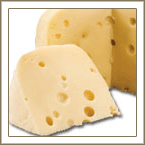
![]()
Heritage:
In Wisconsin, cheesemakers traditionally produce Baby Swiss from whole milk,
unlike traditional Swiss, which they make from partially skimmed milk. Whole
milk gives Baby Swiss a creamier texture and more buttery flavor, which makes
it ideal for melting.
Description:
Typically made with whole milk. Silky, creamy texture with small eyes.
Mild, buttery, slightly sweet flavor. Slices and melts well. Available plain and smoked.
Flavor:
Mild, buttery, creamy, slightly sweet
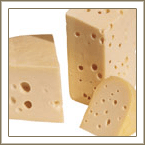
![]()
Heritage:
American cheesemakers, not Swiss, modernized Swiss production. About 50 years
ago, the only way to protect Swiss wheels as they ripened was to allow a
hard rind to form. The advent of plastic packaging, which keeps moisture
in but allows carbon dioxide to escape, made it possible to produce rindless
Swiss cheese in blocks. Rindless blocks were developed for better yield in
food service; retailers appreciate the higher yield and ease of cutting.
Cheesemakers of Wisconsin have a long tradition of producing some of the most
award-winning Swiss in the world.
Description:
Full-flavored, buttery, nutty. Made with part skim milk; aged at least 60 days.
Ideal for table, or on sandwiches and casseroles sliced and melted.
Flavor:
Mellow, buttery, nutty
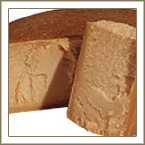
![]()
Heritage:
Since the 11th century, cheesemakers in the Alpine area between Switzerland and France
have produced Gruyere. The pride and joy of the region, this cheese received its name
from the town of Gruyeres in the Swiss canton of Fribourg. Today, Wisconsin cheesemakers
produce award-winning, hand-crafted Gruyere using classic production techniques and
hand-crafted copper vats. The cheese is aged in specially-designed curing rooms to
attain the peak of perfection.
Description:
Nutty, rich, full-bodied flavor. Firm texture with a few tiny eyes.
Surface-ripened with inedible brown rind. Shred for fondue, baked
dishes, melting on onion soup.
Flavor:
Nutty, rich, sweet, full-bodied
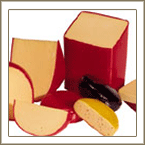
![]()
Heritage:
Gouda and Edam originated in Holland over 800 years ago. The name “Gouda” comes
from a village in southern Holland. The town of Edam shares the same valley.
In the early days of Dutch cheesemaking, cheesemakers wrapped Gouda for export
in red cloth to identify the variety. Today, Wisconsin producers carry on the
tradition by covering the cheese with red wax or cellophane.
Description:
Gouda, made with whole milk, has a rich, buttery, slightly sweet flavor and
smooth, creamy texture. Slice for sandwiches; shred in baked dishes; dice in
salads and vegetable dishes.
Flavor:
Light, buttery, nutty
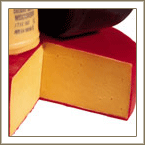
![]()
Heritage:
Prior to 1850, nearly all the cheese produced in the United States was Cheddar.
Cheddar production in Wisconsin began in the mid 1800s and by 1880, more
Cheddar was produced in Wisconsin than any other cheese variety. Today it
accounts for a large percentage of the cheese made in the state, which makes
Wisconsin a leader in U.S. Cheddar production.
Description:
Rich, nutty flavor becomes increasingly sharp with age. Smooth, firm texture
becomes more granular and crumbly with age. Usually golden; also available
white. Slice for sandwiches, snacks; shred into casseroles, soups, sauces.
Flavor:
Rich, nutty, creamy flavor that becomes increasingly sharp and complex with age
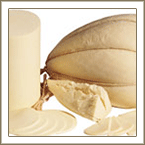
![]()
Heritage:
Producers use more and different cultures to make Provolone than for Mozzarella.
These additional cultures result in fuller flavors and allow Provolone to
age well. In earlier times, Italian cheesemakers heated curing rooms with
wood fires, which imparted a slightly smoky flavor to the cheese. Today,
Wisconsin cheesemakers produce smoked and unsmoked Provolone.
Description:
Flavor changes from slightly piquant when young to sharp when aged. Firm texture
becomes more granular with age. Plain or smoked. Slice for sandwiches; shred
for pizza, fillings; dice on salads.
Flavor:
Full flavor that intensifies and sharpens with age
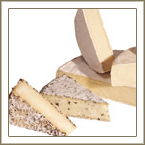
![]()
Heritage:
Wisconsin has become an important source of Brie for American consumers. Brie
is produced in Wisconsin because the composition of milk closely resembles
that of the French regions. The bloomy rind on Brie results from Penicillium
Candidum, a white mold applied to the surface. The mold produces enzymes
which ripen the cheese from the outside in. Ripening occurs in just a matter
of weeks.
Description:
This classic French cheese is now made in Wisconsin. Rich, earthy mushroom
flavor changes from mild when young to pungent with age. Available plain and
with flavors. Soft, creamy interior with snowy white, edible rind. Slice on
sandwiches; spread on bread; wrap and bake in pastry. Remove rind and stir
into soups, sauces.
Flavor:
Mild to pungent, depending upon age, rich, earthy mushroom
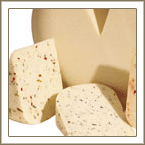
![]()
Heritage:
A Scotsman named David Jacks first produced Monterey Jack in the 1890s. This
popular cheese retains its place name even when made elsewhere. In Wisconsin,
cheesemakers produce a variety of Monterey Jack cheeses in a variety of flavors,
such as Pepper, Dill, Salsa and some savory and fruit based flavors.
Description:
Delicate, buttery, slightly tart flavor. Available plain and with flavors.
Creamy, open texture. Slice for sandwiches; shred in casseroles, soups, Mexican-style
dishes.
Flavor:
Delicate, buttery, slight tartness
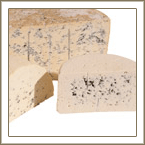
![]()
Heritage:
No record exists of the first Blue cheese. Some historians suggest that mold
from the penicillium family was accidentally transferred from bread to a
nearby piece of cheese. Because the development of blue mold occurred randomly,
Blue cheeses were highly prized. Today, cheesemakers add appropriate mold
cultures to develop blue veins in the cheese. Wisconsin cheesemakers make
a variety of award-winning Blue cheeses ranging from crumbly to creamy.
Description:
Piquant, full, earthy flavor; intensity of flavor varies among brands. Firm,
crumbly texture with blue mold in veins and pockets. Crumble in vegetable,
fruit and pasta salads, over grilled meat; blend for spreads, dressings, dips.
Flavor:
Piquant, with a full, earthy flavor as a result of the blue mold (fungi) in the
cheese; some styles are milder, not as earthy, yet still piquant; some are salty
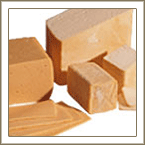
![]()
Heritage:
Brick is a Wisconsin original, first made by John Jossi around 1877. Some Brick
cheeses resemble Germany’s surface-ripened Beer Cheese or Beer Käse. Brick was
named for its shape and because cheesemakers originally used bricks to press
the moisture from the cheese. Wisconsin leads the nation in the production of
Brick and surface-ripened Brick. The bacteria that cheesemakers apply to
surface-ripened cheeses, known as a smear, develops the full, earthy flavor.
Description:
A Wisconsin original. Flavor changes from mild and sweet, with a touch of
nuttiness when young to pungent and tangy when aged. Available surface-ripened.
Smooth, open texture. Slice for sandwiches; shred for casseroles.
Flavor:
Mild: sweet, with a touch of nuttiness; Aged: pungent, tangy; Dry rind: mild to
pungent, depending on age; Washed rind: mild to pungent, depending on whether
it is mild, medium or aged
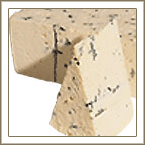
![]()
Heritage:
Wisconsin Italian-style Gorgonzola resembles the dolce latte or sweet milk
Gorgonzolas of Italy that are especially creamy. Gorgonzola gets its name
from the town located in the Po Valley near Milan where it has been made
since 879 A.D. Firm Gorgonzola produced in Wisconsin has less moisture and
is more crumbly. Gorgonzola is typically produced in flatter wheels than
the traditional Blue. Italian-style Gorgonzola ripens to yield a soft, creamy
texture and its flavor is more earthy than sharp.
Description:
American style: Full, earthy, piquant flavor. Crumbly texture. Use on salads
or hamburger. Great in sauces and dressings. Italian style: Slightly piquant,
full, earthy flavor. Creamy, soft interior with greenish blue veins and rusty
brown inedible rind. Heat and toss with hot pasta; spread on bread or toast;
stir into risotto.
Flavor:
Italian-style: Full earthy flavor, slightly piquant; Firm: Sharp with a slight
earthiness
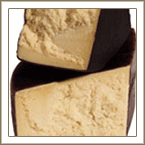
![]()
Heritage:
Asiago derives its name from a small town in northern Italy. In Italy,
Asiago usually means Asiago Fresco (fresh), which has a mild flavor and
semi-hard texture. In Wisconsin, cheesemakers age Asiago to develop sharper
flavors. It resembles a cross between sharp white Cheddar and Parmesan.
Description:
Flavor changes from mild when young to sharp, buttery and nutty when aged.
Flavor similar to a blend of aged Cheddar and Parmesan. Texture changes from
elastic and firm to hard and granular with age. Serve as a table cheese;
shred or grate into cooked dishes.
Flavor:
Fresh: clean, mild; Medium: more intense; Aged: buttery, nutty;
similar to Parmesan
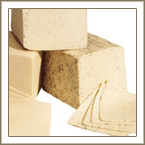
![]()
Heritage:
Havarti, a milder version of German Tilsit, was first made popular in Denmark.
Many cheesemakers in Wisconsin produce a product similar to its Danish cousin.
The Center for Dairy Research at the University of Wisconsin-Madison developed
a special Wisconsin-style Havarti® that is firmer in texture and more
buttery in flavor than other types.
Description:
Buttery, slightly acidic flavor. Available plain and with flavors. Smooth,
supple texture with tiny holes. Slice for sandwiches; shred in egg dishes;
dice on salads.
Flavor:
Buttery, creamy, slightly acidic
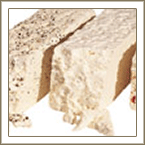
![]()
Heritage:
Feta was first made in Greece from sheep's or goat's milk. In Wisconsin, producers make
Feta from cow's milk. Cheesemakers refer to Feta as "pickled" because, after formation,
it is packed in brine (salt and water). The brine preserves the cheese for
approximately six months longer than most fresh cheeses.
Description:
Fresh cheese packed in brine and referred to as "pickled". Crumbly, firm texture.
Tart, salty flavor. Crumble on salads or use in casseroles or stuffings.
Flavor:
Tart, salty
California Table Wine ©2005 Gallo of Sonoma, Healdsburd, Sonoma County, Ca. All rights reserved © 2005 WMMB, Inc.
Use of this site is subject to the
use agreement
and privacy policy
and trademarks.